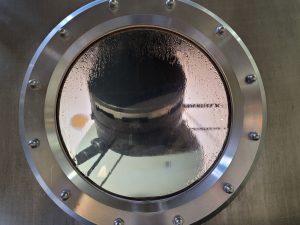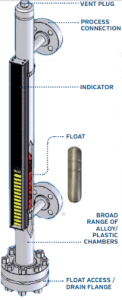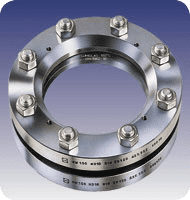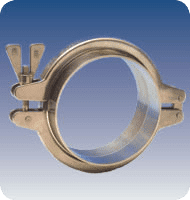LJ Star’s weld-on and magnetic level gauges provide safe and accurate sight indication of fluid levels in a tank, process vessel or boiler.
What is a Liquid Level Gauge?
Liquid level gauges are industrial meters that are used to determine the level of a liquid in a process tank. Liquid level gauge calibration is used to ensure proper readings are obtained when using level gauges.
How Does a Magnetic Liquid Level Gauge Work?
Magnetic level gauges use magnetism to link the indicator in a gauge to a float inside of a vessel in order to accurately show the level of fluid within. As the position of the float changes, the indicator moves up or down by the same amount, meaning that the level in the measuring chamber will always be the same as the fluid level in the vessel itself.
Operating on the principle of conductivity, magnetic level gauges consist of 3 main components: the chamber, the float, and the indicator. The chamber is the main component and can be constructed of any non-magnetic material. It is typically mounted to the side of the vessel, with the liquid level in the chamber set up to match the liquid level in the vessel. While similar to a traditional sight glass in this way, magnetic level gauges can handle some of the more extreme applications, such as ones with highly corrosive or hazardous materials.
To actually get a reading, the ancillary chamber of the magnetic level gauge uses a float that contains a set of permanent magnets. This float is normally constructed of 316 stainless steel or titanium but can be produced using other materials where needed. When the fluid fluctuates in the primary chamber, it results in a proportionate change in the magnetic level gauge.
What are the Different Types of Liquid Level Gauges?
Magnetic Liquid Level Gauge
LJ Star’s weld-on and magnetic level gauges provide safe and accurate sight indication of fluid levels in a tank, process vessel or boiler.
The advanced non-intrusive design of the MagnaStar™ magnetic level gauge provides accurate level readings while protecting operators from high pressure and/or high temperature fluids. More than a safety device, the MagnaStar’s rugged design also minimizes operating costs by eliminating downtime due to leaks or required maintenance.
The MagnaStar level gauge has no glass tube to replace or multiple gaskets to maintain. The two-color indicator, easily read from a distance, is mounted on the chamber but completely isolated from the process fluid. The indicator magnetically locks onto the position of the float inside the sealed chamber, moving up and down as the position of the float changes, which provides an accurate real-time indication of the liquid level inside the tank.
The indicator is magnetically stabilized to further ensure accurate level readings regardless of vibration or shock. Our durable Rectangular Weld-On for level indication is welded into a vessel or a pipeline to provide either flow or level indication.
The gauge is available in carbon steel, stainless steel and special alloys, in either obround or rectangular visible glass fittings. Custom gauge designs are also available.
Armored Level Gauges
Armored Level Gauges are flat glass gauges used where direct visual observation of process fluids is required. These gauges are available in two main types: reflex and transparent. They are suitable for a wide range of applications with pressures up to 6000 PSIG @ 100°F, and temperatures up to 800°F to 2620 PSIG. LJ Star armored level gauges are available in either carbon steel or 316 stainless steel construction materials to meet most specifications for your specific process conditions such as:
Reflex Level Gauges
Reflex Gauges use prism glass to provide an excellent indication of the liquid level. All liquids appear black in contrast to the mirror-like surface above. This clean line of separation can be sighted from many yards away.
Available in three pressure-based series, RL, RM and RH, Reflex Level Gauges use glass with molded prisms on the process side designed to absorb light when filled with liquid, and to reflect light where vapor is present, for a clear distinction between liquid and vapor even from a substantial distance.
Transparent Level Gauges
For Pressures up to 3000 PSIG @100°F
Transparent Gauges use clear, see-through flat glass on both sides, allowing sufficient light so that both the color and the interface of liquids can be viewed. Electric lighted gauge illuminators are available for use on transparent gauges to supplement ambient light. As a result they are ideal for easy viewing of liquid levels in dimly lighted areas. Standard Transparent Level Gauges are designed for -200°F service.
Tubular Gauge Glass Assemblies
Glass-Trac Tubular Glass Gauges use strong clear glass or red line to provide a complete 360° view of the liquid level. Available in any length desired, Glass-Trac Tubular gauges can be fitted with tubular style gauge valves for. Guard rods and plastic tubular protectors are also available for added protection.
Steam-Track Steam Gauges
The Steam-Trac steam gauges, in five models supporting pressures as high as 3000 PSI, are made from reflex borosilicate glass with prisms molded into the process side that display black for water and white for steam. Designed with materials that fully comply with ASME requirements, it can be used as a direct reading sight glass as required by ASME Section 1, PG.60.
With multiple sections and a continuous one-piece chamber, Steam-Trac units can be custom built to your specifications. All model units include high temperature coatings, spring washers for consistent torque and quality nickel-plated bolts, nuts and washers.
MAGNE-TRAC™ Level Indicators
Magne-Trac liquid level indicators are easy to install, low maintenance and easy to view. Chambers are constructed of non-magnetic materials, including austenitic stainless steel, alloys or plastics. They are compliant to ASME B31.1 and 31.3. Each float is custom engineered for a specific application or operating process. The unit’s standard indicator consists of anodized aluminum housing, rotating flags and a clear cover. Standard indicators are UV stable with yellow/black flags constructed of high temperature, scratch-resistant, non-corrosive molded nylon,
How to Choose the Right Liquid Level Gauge for Your Application
It’s always important to specify a proper magnetic level gauge that’s suitable for the operating conditions of your specific process. This will be heavily influenced by:
- Vessel type
- Temperature
- Fluid density
- Working pressure
Aggressive fluid can be addressed by adjusting the construction of both the chamber and the float to higher-grade materials such as Hastelloy or Alloy 20.




